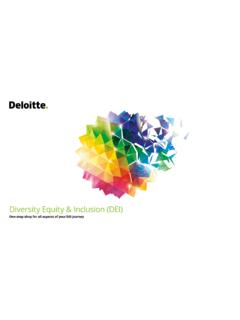Transcription of The six signature traits of inclusive leadership - Deloitte
1 The six signature traits of inclusive leadershipThriving in a diverse new worldDeloitte s Human Capital professionals leverage research, analytics, and industry insights to help design and execute the HR, talent, leadership , organization, and change programs that enable business performance through people performance. Visit the Human Capital area of to learn Dillon is a client director in Human Capital consulting at Deloitte , where she special-izes in diversity and inclusion. A chartered accountant by background, she has worked with a range of organizations, both locally and internationally, with respect to diversity and inclusion strategy development, inclusive leadership assessment and development, analytics and diagnostics, and inclusive culture change. Dillon has co-authored a number of publications relating to diversity and inclusion, and is currently based in the United Kingdom. Juliet Bourke is a partner in Human Capital consulting at Deloitte , where she leads the Australian Diversity and Inclusion practice and co-leads the Australian leadership practice.
2 She has over 20 years experience in human capital and is an internationally recognized author and speaker on diversity and inclusion, cultural change, and leadership . Bourke has authored many publications on diversity and inclusion, most recently publishing Which two heads are better than one? How diverse teams create breakthrough ideas and make robust decisions, which examines decision making, diver-sity of thinking, biases, and the authorsContentsIntroduction: A new leadership capability | 1A diverse new world: Markets, customers, ideas, and talent | 4 The six signature traits of an inclusive leader | 7 What can organizations do? | 19 Appendix: Research methodology | 21 Endnotes | 23 Contacts | 25 Acknowledgements | 26 The six signature traits of inclusive leadershipivIntroduction: A new leadership capabilityWHAT will it take to be a great leader in the future? In five years, ten years, even fifteen years?
3 Say those numbers slightly differ-ently 2020, 2025, or 2030 and your imagi-nation takes you somewhere else entirely. To the realm of science fiction in which books and films paint vivid pictures of a future that looks vastly different from that which we know today. There is the devastated world and its dystopian societies, the artificial world with synthetic humans, and myriads of other worlds scattered throughout foreign galaxies. In these books and films, there s always a quest, and there s always a hero. Smart and strong, they carry the weight of the world on their shoulders. They have a sidekick, if lucky, but rarely are the leader and the sidekick equals, and they almost never operate as a team. The decisions these leaders make the actions they take culminate in the restoration of humanity. What s curious is that this iconic image of the heroic leader remains constant despite the vastly changed environment. It seems we can easily imagine different future contexts, but when it comes to thinking about leadership differently, we are on a repeating loop.
4 It makes for great entertainment, but it is not the stuff of reality. Yes, the context will change it is changing already and this will demand adap-tation by those playing a leading role. So what is this different context? In a vola-tile and complex world, predicting the future with precision is a risky business. We can be sure, however, about four global mega-trends that are reshaping the environment and influ-encing business priorities:1 First, diversity of markets: Demand is shift-ing to emerging markets. With their growing middle class, these new markets represent the single biggest growth opportunity in the port-folio of many companies around the , diversity of customers: Customer demographics and attitudes are changing. Empowered through technology and with greater choice, an increasingly diverse cus-tomer base expects better personalization of products and services. Third, diversity of ideas: Digital technol-ogy, hyper-connectivity, and deregulation are disrupting business value chains and the nature of consumption and competition.
5 Few would argue against the need for rapid innovation. Fourth, diversity of talent: Shifts in age profiles, education, and migration flows, along with expectations of equality of opportu-nity and work/life balance, are all impacting employee populations. Diversity of markets, customers, ideas, and talent: These simultaneous shifts are the new context. For leaders who have perfected their craft in a more homogenous environ-ment, rapid adjustment is in order. Of course, Thriving in a diverse new world1 Graphic: Deloitte University Press | 1. The six signature traits of an inclusive leaderCognizanceBecause bias is a leader s Achilles' heelCuriosityBecause different ideas and experiences enable growthCommitmentBecause staying the course is hardCollaborationBecause a diverse-thinking team is greater than the sum of its partsThe sixsignaturetraitsCourageBecause talking about imperfections involves personal risk-takingCulturalintelligenceBecause not everyone sees the world through the same cultural frameThe six signature traits of inclusive leadership2the core aspects of leadership , such as setting direction and influencing others, are timeless, but we see a new capability that is vital to the way leadership is executed.
6 We call this inclu-sive leadership , and our research has identified six traits that characterize an inclusive mind-set and inclusive behavior. This report is intended to help leaders think about how traditional notions of leadership must We are not suggesting a whole-sale replacement of previous leadership theory. Elements of inclusive leadership are echoed in transformational, servant, and authentic leadership , for example, and these concepts are carried forward. However, we have amplified and built on these known attributes to define a powerful new capability uniquely adapted to a diverse environment. Understanding and being adept at inclusive leadership will help leaders thrive in their increasingly diverse report is structured in three parts. First, we briefly describe the four shifts elevating the importance of inclusive leader-ship the Why care? aspect of the discus-sion. In the second part, we have identified the six signature traits of an inclusive leader (figure 1).
7 In doing so, we have mined our experi-ences with more than 1,000 global leaders, deep-diving into the views of 15 leaders and subject matter experts, and surveying over 1,500 employees on their perceptions of inclu-sion. We have also built on existing thought leadership and applied research and drawn on work with our inclusive leadership assess-ment tool on which our six-part framework is based which has proved both reliable and valid in pilot Sensing that inclusive leadership is a new capability, we have been examining this space since 2011, rather than relying solely on pre-existing leadership assess-ments and databases, with their historic biases. We conclude with some suggested strategies to help organizations cultivate inclusive capabili-ties across their leadership in a diverse new world3A diverse new world: Markets, customers, ideas, and talentFOUR global mega-trends are creating a business context that is far less homoge-nous and much more diverse than has histori-cally been the case.
8 These interrelated shifts are influencing business priorities, and reshaping the capabilities required of leaders to succeed in the future. Diversity of markets The growth in emerging market econo-mies may have slowed and big challenges abound but the long-term potential remains 2025, the world s middle-class popula-tion is expected to reach billion, up from billion in 2009, with the majority of this growth coming from Asia, Africa, and Latin As income levels rise, so does con-sumer demand. This growing population now represents the single biggest growth oppor-tunity in the portfolio of many companies around the these consumers profitably, how-ever, is anything but Markets are characterized by significant cultural, politi-cal, and economic differences. Tension exists between local adaptation and international scale. Home-grown players can provide stiff competition and strong local talent is scarce. Indeed, in a 2015 survey of 362 executives, just 10 percent believed that they have the full suite of capabilities needed to win what does this mean for those with global ambitions?
9 While there is no single formula for success, research shows that having people with a more global mindset and capa-bility is John Lewis, Jr., global chief diversity officer of The Coca-Cola Company, agrees: Right now, our fastest-growing markets around the world are sub-Saharan Africa, India, and China. How we win in these markets is as much a matter of how we embed ourselves in these cultures [as any other fac-tor]. The question I put to our business leaders is: Even if we get all the tactics and logistics right, can we win if we don t get the people part right? 10 Diversity of customersCustomers have always been able to vote with their feet. Today, this power is even greater. Empowered through their digital devices and with more choice, customers expect greater personalization and a voice in shaping the products and services they Facing millions of individual expecta-tions and experiences across an increasingly diverse customer base, the challenge for com-panies is to deliver individualized insights and a personal touch with the efficiencies of remain competitive in this environment, organizations have realized, customer cen-tricity is paramount.
10 Customer promises are being written into vision statements, operating The six signature traits of inclusive leadership4models are being redesigned to ensure that customers are at the heart of the business, and the role of the chief customer officer has been created and elevated to the executive team. But more than just changing systems and structures, organizations are increasingly focusing on cultivating more customer-centric mindsets and capabilities. The new buzzwords of empathy and connectedness concepts that underpin popular methods such as design thinking are taking hold as organizations strive to better understand customers worlds and future needs. And while development programs of the past may have focused on traditional customer-facing roles, a leader-led approach is increasingly being adopted. Telstra has embarked on a journey to orient the entire organization around the customer, including the way leaders are developed. Leaders are central to the connected strategy, says Rob Brown, director of customer advo-c a c They are the linchpin that sets the pace and culture of our organization.












